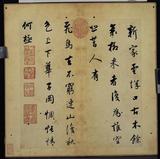明陳憲章畫梅花 軸
推薦分享
資源連結
連結到原始資料 (您即將開啟新視窗離開本站)後設資料
- 資料識別:
- 故畫000428N000000000
- 資料類型:
- 繪畫
- 著作者:
- 陳憲章
- 主題與關鍵字:
- 梅(白.紅.蠟梅)
- 日期:
- 明英宗正統二年(1437)
- TIME STAMP:17-7月 -07
- 格式:
- 本幅 116.5x61.7公分&全幅 63.9公分
- 關聯:
- 石渠寶笈續編(寧壽宮),第五冊,頁2791&故宮書畫錄(卷五),第三冊,頁310&故宮書畫圖錄,第六冊,頁285-286&陳憲章,活動於明英宗正統(西元一四三六-一四九九年)年間,浙江會稽人。善於畫梅花,畫史中對他的記載,僅說他和同時的王謙齊名。 這一幅作品畫橫垂的梅花,分出的二枝主幹,均用濃墨畫出。梅花的部分,則以圈瓣的方式來表現,然後用淡墨全面的渲染絹底,更襯托出花瓣的白。整幅畫的不是梅花的清,而是梅花的密,千花萬瓣中,呈現出一片花團錦簇的熱閙景象。&陳憲章,英宗正統(公元一四三六-一四九九年)年間,浙江會稽人,生卒年不詳。善畫梅花,畫史僅稱他與王謙齊名。 本幅水墨畫老梅橫垂,分枝為二,濃墨畫幹,圈瓣畫梅,復以淡墨漬染絹底,遂使千花萬蕊益發突出,呈現一片花團錦簇,繁複熱閙的景象。 & Ch’en Hsien-chang was a native of K’uai-chi, Chekiang, who excelled at depicting plum blossoms. He is recorded in traditional texts on painting history as being as famous as Wang Mien (1287-1359) in plum blossom painting. This is a painting in monochrome ink of a bifurcating old plum branch that is suspended horizontally and rendered in dark ink. To the circular petals of the blossoms have been added light ink washes that serve as a base on the silk and provide a dimension of depth to the blossoms. The artist has indeed created a scene of a panoply of flowers in riotous profusion.
- 管理權:
- 國立故宮博物院
授權聯絡窗口
- 國立故宮博物院圖像授權、出版授權、影音資料授權-申請流程說明
http://www.npm.gov.tw/zh-TW/Article.aspx?sNo=03003061






